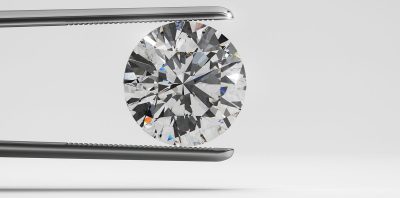
What Are Diamond Simulants?
Diamond simulants are natural or synthetic stones which look very similar to natural diamonds and share some of its characteristics but have different chemical properties.
In fact, before a material can be considered for use as a diamond simulant, it must first possess certain diamond-like properties. Therefore, the most advanced diamond simulants have properties which very closely resemble diamonds.
Natural diamonds are entirely made out of carbon while diamond simulants are crystals formed from natural minerals such as zirconium oxide or strontium titanate.
Because simulants do not have the same exact chemical and physical properties as diamonds, they sell at much lower prices compared to natural or lab grown diamonds.
However, despite the difference in chemical and physical properties, diamond simulants imitate the appearance of a diamond very closely and most jewelers and gemologists are unable to tell the difference between a real diamond and a diamond simulant with the naked eye.
Often, it takes an experienced gemologist with a microscope loupe to distinguish the difference between a real diamond and a diamond simulant.
Why Should I Buy a Diamond Simulant?
Diamond simulants are a great option for those who wish to buy a diamond-like stone but do not wish to break the bank while doing so.
If you have a particular setting or diamond size in mind, wallet friendly simulants can allow you to own a piece of jewelry that you adore without having to wait. You can always upgrade to a natural or lab grown diamond at a later date and when the time is right for you.
For frequent travelers or forgetful, a diamond simulant may represent a peace of mind. You don’t have to be mindful all the time about your jewelry and the risk of losing or having it stolen is considerably lower.
How Are Diamond Simulants Different From Natural Diamonds?
Weight: Diamond simulants are heavier than diamonds of the same size.
Hardness: Diamonds rank 10 on the Mohs scale. Diamond simulants are not far behind, ranking between 8 to 9.1 and is harder than many semi-precious gemstones and precious stones such as sapphire and ruby.
Refractive Index & Light Dispersion: Diamond simulants have a lower refractive index than diamonds 2.15 compared to 2.42 but it has a higher light dispersion than diamonds, meaning that you see more colored light dispersing out of the stone.
Inclusions: Diamonds are formed naturally and thus have small imperfections known as inclusions within. A diamond with no inclusions is graded as F (flawless) or IF (internally flawless) and is very rare and expensive. Diamond simulants have no inclusions as they are grown artificially.
Colour: Diamonds come in a range of colors from colourless to yellow/brown hues. They are categorized alphabetically from D to Z, with D colorless white being the most desirable and therefore the most expensive. Diamond simulants are colorless.

The Misconception About The Mohs Hardness Scale
In gemology, “hardness” is defined as the ability to resist scratching which is different from the layman’s understanding of “hardness”.
A diamond is scientifically defined as hard and rated 10 on Mohs scale. Yet it is also brittle, the steel of a hammer (rated Mohs 5-6) wont scratch it but it can shatter it.
While diamond simulants are not as hard as natural diamonds, they are still quite highly ranked on the Mohs scale and can even scratch glass.
Why Is The Cut Important?
Just like diamonds, the brilliance and luminosity of a diamond simulant depend on the technique and experience of the stone cutter. Cutting facets in the stone will determine how much a stone refract light, thus maximizing the “fire” (which is the colored sparkle that you see when the stone is exposed to light).
A stone cut by an inexperienced stone cutter with poor technique can result in minimal brilliance and luminosity and lack the brilliance of a natural diamond. On the other hand, a diamond simulant which is properly hand cut by a professional can have the same luminosity and brilliance of a real diamond and may be indistinguishable to a jeweler of gemologist, even with a magnification loupe.
Can You Tell If A Diamond Is Real Or A Diamond Simulant?
How does one tell the difference between a diamond and a diamond simulant? Most jewelers and gemologists are unable to tell the difference with the naked eye and most would request to use a magnification loupe for further examination.
For a more accurate test, a diamond test kit may be used, which will test the rate at which heat moves through the stone or by testing the electrical conductivity through the stone.
A popular layman’s test is the breath test. You can do it by breathing heavily over the stone. A diamond simulant will fog up and the fogginess will linger for awhile whereas a diamond will clear up almost immediately. This test is based on the fact that heat disperses faster through diamond. However, this test is only an indicative test and not 100% representative. You will still require further examination by a professional to confirm the authenticity of your stone.








